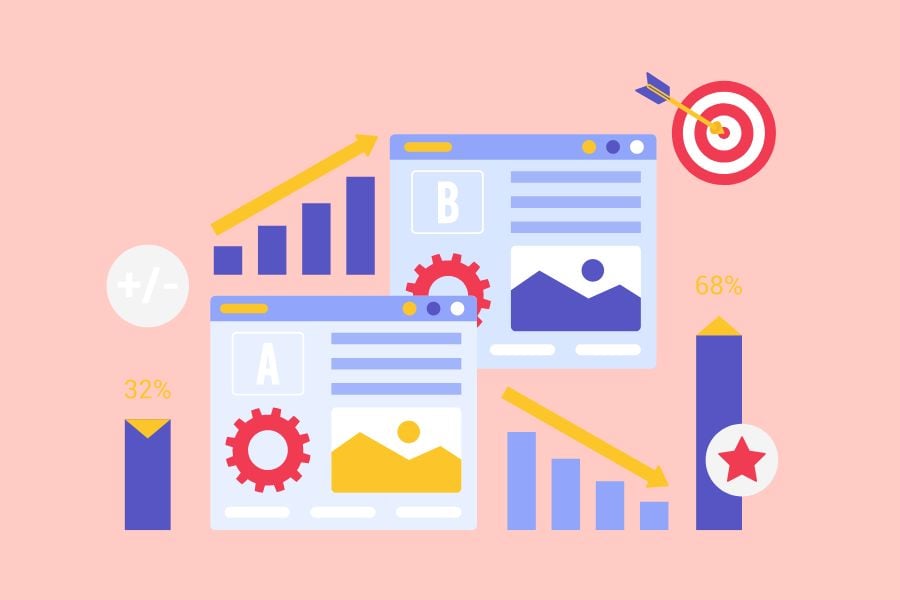What is A/B testing? More importantly, how does it work?
In the baffling world of online marketing, some see A/B testing as an annoying hoop to jump through before you get results.
When done properly, it can make a real difference to your bottom-line profits.
So, we delve into the murky details, explain exactly what A/B testing is, and how you can set up simple split testing in 10 easy steps.
Ready?
Let’s begin.

What is A/B Testing?
Also known as split testing, AB testing compares a single element in one piece of writing against another. Don’t confuse it with the more complicated multivariate testing.
For instance, you’ve come up with a couple of great headlines for a landing page on your website.
You’re undecided about which will work best, and you want as many leads as possible… But which should you choose?
A split test presents Headline A to one user group of readers and Headline B to a different user group.
By comparing the conversion results for each headline, you can determine which headline is more effective.
On the other hand, multivariate testing, while similar to A/B testing, analyzes multiple elements of a document at the same time. For example, a headline, call-to-action button, and hero image.
However, by keeping things simple, you’ll have a greater chance of getting a more meaningful test result.
Benefits of A/B Testing
The benefits of A/B testing are clear. You receive evidence based on real-time customer behavior so you can adjust your marketing campaign. In turn, this gives a better user experience.
Let’s look at the data:
- Improves content engagement: Is your writing ‘sticky’ enough? Does it capture the attention of your visitor and get them to take action?
- Reduces bounce rate: How can you encourage people to stay longer on your web pages? Or stop them from deleting your email message?
- Boosts Conversion Rate: How do you optimize your copywriting, so your web page browsers turn into buyers?
- Expand sales: The lifeblood of your business! More sales = growth.
- Genuine proof of results: Black & white evidence is hard to refute. Cut down on trying to guess what works. Go straight to your customers for their thoughts.
Now that we’ve explored the benefits, let’s put everything into practice…
How to Conduct Split Testing in 8 Simple Steps

While detailed A/B testing instructions and multivariate testing are beyond the scope of this post, we’ve broken down the essential elements you need.
Follow the steps below to create an ab test that brings results…
Step 1: Pick One Feature to Test
Choose one element. This ensures that any difference in conversion rates between the A and B options is due entirely to that element.
From this two-way divide, a clear winner will emerge.
For instance, you’ve created an opt-in form for your website and have been less than impressed with the results.
But you don’t know why people aren’t signing up.
So, pick two variations of a single element in the form while keeping everything else the same.
You could try two different call-to-action buttons, different images, or copy.
If you’re still not happy with the test result?
Continue testing one version against another until you’ve found your perfect combination.
Step 2: Designate the Control (A) and the Challenger (B)
In A/B split testing, there are two groups — the control group (version A) and the challenger group (version B).
The control is the original version of something you want to test, and the challenger is a modified version.
The purpose of the challenger is to test whether the changes made to it will result in a better performance than the control.
By comparing each group’s performance, you can see which is better.
Elements you may consider changing include images, as well as headlines, and copy.
But, remember, change a single element at a time to get the best data.
Step 3: Select an AB Testing Tool
Selecting an AB testing tool can be a daunting task with so many options available in the market.
A few factors to consider are ease of use, integration with your website, and statistical significance.
Choose one with an easy-to-use interface that doesn’t require a lot of technical knowledge to set up and use, and you’ll soon see the benefits.
Some popular tools in the market include Optimizely, VWO, and AB Tasty.
If, however, email marketing is your focus, check if your provider offers split testing.
Here are 8 of the best email marketing software companies that offer a range of services, including A/B testing.
Step 4: Set an Adequate Test Duration
When split testing, you need to find the optimal balance for the duration of your test.
Too short, and the results may not be reliable.
And if the test is too long, the results may be out of date.
So, how long should you test for?
Well, Niel Patel states you should test for a minimum of seven days.
Step 5: Use a Suitable Sample Size
Getting the right sample size is a big deal in A/B testing because it helps ensure your results mean something.
If your sample size is too small, your results might not be true for everybody.
But if your sample size is too big, it can complicate the test run.
Hubspot suggests a minimum of 1,000.
By picking the right sample size, you can be more confident that your results are accurate and will help you make smart choices.
Step 6: Decide What Is a Statistically Significant Result
A/B testing compares two different versions of a web page, email, or other digital asset to see which one performs better.
In order to determine whether the difference in performance is significant or simply due to chance, we use statistical significance.
Statistical significance means that the measured difference between the two different versions is probably not a coincidence.
In other words, it’s likely to be a real difference, not just random chance.
By relying on statistical significance, you can feel more confident in your test results.
Step 7: Run the Test & Analyze the Results
Now you’re ready to start the test. Surely you can sit back and relax?
Unfortunately not. This is where the hard work begins.
To determine if the challenger performed better than the control in the split test, you need to analyze your results.
It involves comparing the performance of both groups based on the test goal, like website traffic or email open rate.
If the difference between the groups is significant, meaning it’s not due to chance, you can confidently conclude that the challenger is better.
But if the difference is not significant, it’s best to stick with the control.
You can also try a new variation in additional tests to see if you can achieve better results.
Step 8: Make Changes Based on Your A/B Test Results
Here are some ways to make changes based on the your ab test results:
- If the challenger wins, implement the changes on a larger scale to reap the benefits of the improved results.
- If the control wins, consider making further tweaks and conducting additional tests until a statistically significant improvement is achieved.
- Continuously test a new variation to improve performance and stay ahead of the competition.
Remember, the goal is to use the results of A/B testing to make informed decisions and continuously improve your strategy.
How to Avoid SEO Impacts During Testing

To avoid negative impacts on SEO during split testing, it’s important to use best practices and guidelines from search engines like Google.
Some tips to consider are:
- Maintain content production
- Avoid cloaking
- Use canonical tags
- Test changes on a small subset of pages
- Monitor page performance
Advice from top SEO experts is to guard against hiding or cloaking.
Instead, focus on creating high-quality content that meets the needs of your target audience.
Following best practices ensures successful A/B testing without harming your search engine rankings.
15 Key Items You Should A/B Test for Big Results

Stuck for ideas on what to test? We’ve broken down a few key items to consider…
Blog Items to Split Test
Consider these blog elements for big results in A/B testing:
- Headline: Try different headlines to see which one resonates with your target audience and generates more clicks.
- First sentence: Experiment with different opening sentences to see which one hooks your reader and keeps them engaged.
- Intro section: Test different ways to introduce your topic to see what draws in your audience and keeps them interested.
- Subheadings: Test different subheading styles to make your post more scannable and help readers find what they’re looking for.
- Call-to-action: Experiment with different types of calls-to-action to see which one encourages readers to take action and engage with your content.
Testing these elements can help you identify what works best for your audience and improve your blog’s engagement and conversion rates.
Email Items to Split Test
What about using these email elements to test for big results in split testing?
- Subject line: Test different subject lines to see which ones get more opens and better engagement from your audience.
- Introductory story: Test different ways to introduce your topic and make an emotional connection with your readers.
- Transition from story to selling: Try different ways to move from your story to the main point of your email and see what drives more clicks.
- The hook: Test different types of hooks to see which ones encourage readers to take action and engage with your email.
- The sign-off: Try different variations of your email close to see which strikes a chord with your audience.
Testing these elements can help you improve your email open rate, click-through rates, and overall engagement with your audience.
Website Items to Split Test
We can’t talk about items to test without suggesting website alterations. Here are a further 5 considerations:
- Title: Test a different variant of your title to see which one resonates with your audience and drives more clicks.
- Information above the fold: This includes the first few sentences of your website, as well as any images or other content that appears before a visitor has to scroll.
- Length/word count: Test shorter vs. longer versions of your website content to see which ones hold visitors’ attention better and drive more conversions.
- Images: Test different types of images, such as photos vs. illustrations, or different image placements to see which ones are most effective in engaging your audience.
- The close: This is the last section of your website content where you make a call-to-action or ask your visitors to take a specific action. Test different variations to see which ones drive the most conversions.
Remember to test only one element at a time to get accurate results, and always have a clear goal in mind for each test.
Ready to See Results? Discover the Power of A/B Testing (& Improve Your ROI)
You’ve come a long way. You’ve discovered how A/B testing can help you improve your website, email, and marketing campaigns.
By testing a different content variant, you’ve explored what works best for your audience and increases your conversions.
With split testing, you can make data-driven decisions and take your marketing efforts to the next level.
So, what will you test next?
The post What is A/B Testing? 8 Easy Steps for Split Testing (+ Key Items) appeared first on Smart Blogger.

No comments:
Post a Comment